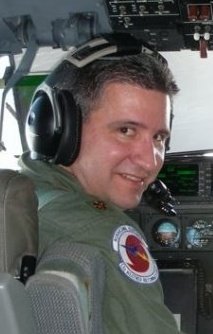Flying into Jimena

Major Jeff Ragusa of the Hurricane Hunters gave me permission to reproduce his recent story on their missions into Hurricane Jimena from their fan page. Here is that account…
I am part of the USAF Reserve crew tasked with collecting the weather data from inside Hurricane Jimena at 1500 hours “Zulu” time on September 1st. Here is a brief synopsis of this particular Hurricane Hunter mission.
I will write this off and on throughout the flight. As I begin, the plane, under the command of Major John Wagner, is climbing out over the city of New Orleans. The primary Loadmaster, MSgt Ed Scherzer, actually came to get me so I didn’t miss the view of the Crescent City. It is only about 4:45 am over New Orleans, but it is lit up like a Christmas tree. I can’t help but wonder about the activity below. I doubt that they are wondering about us at all. We are en route to a storm in the Eastern Pacific, Hurricane Jimena… Category FOUR Hurricane Jimena! In fact, the Instructor Weather Officer, Lt Col John Talbot, told us in this morning’s mission briefing that it was nearly a Category 5 with no forecasted weakening until after we depart the storm much later today.
Lt Col Talbot is along today providing the finishing touches on the training of one our newest Weather Officers, Captain Tobi Baker. Tobi has been gaining experiencing for two seasons now. I’ll ask him later if this will be his first category 4 or 5 storm. In one of the pilot seats is our newest pilot, Lt Ben Blair. As with all new WC-130J pilots, his C-130 training was accomplished entirely in the simulator. This is only his second time in the real plane. In between the takeoff and landing, he’ll be experiencing his first ever hurricane too. Good luck, Ben!
I get the sleep-now-fly-later shift. Not a bad deal. I’ll be asleep in a few minutes, while it’s smooth, then I’ll get to wake up for the “exciting” part. Since Ben is new, we brought two instructors along, myself and Major Wagner. We also brought along a fourth pilot, Lt Jarod Hamblin, to build up his experience, although this isn’t his first rodeo.
Before I hit the top bunk for my nap, I’ll fill you in on the plan. We’re cruising to the storm at the highest altitude we can attain at this weight, 155,000 pounds. As we burn fuel and get lighter, we’ll keep climbing which helps us save fuel. We should end up around 28,000 feet above sea level. As we near the storm, we’ll run some preparation checklists and review the storm procedures. We’ll descend to 10,000 feet in order to remain below the freezing level. Flight above the freezing level in this environment would cause many problems for our plane including icing, more hail, more lightening strike potential, and reduced low-level data collection accuracy. We’ll also slow the plane down from our regular cruising speed of about 350 MPH to our turbulence penetration speed of around 200 MPH. The wings like that a lot better. We’ll fly an X-shaped pattern bringing us into the eye twice today. After that, our fuel state will require us to head back home. We looked at the satellite pictures before we departed which showed us that we can expect a pretty well-developed eye wall. I’ll try to get pictures and/or video to post.
Now I’m off to sleep. It’s 1015 hours Zulu time now.
It’s now 1740 Zulu time (12:40 pm back in Mississippi). We are headed back home after a successful mission. Lt Hamblin and I are in the pilot seats after both getting a 4-hour nap en route to the storm. Most of the rest of the crew has finished their work for now and are sleeping. We have 3 more hours of flying ahead of us. Our navigator, Captain Dobson, has stayed awake more then the rest of us. He’s still awake… making sure us pilots don’t get lost on the way home. He’s doing that just to tease us. The main parts of his job were accomplished during the flight planning and then in and around the storm where he watched the radar to keep us out of harm’s way. Most people think Hurricane Hunters will fly into anything. Actually, we rely intently on the expertise of our navigators to keep us clear of tornadoes and other “really bad” weather phenomenon.
The storm had weakened a bit before we got there. The eye was still easily visible on radar, but not a spectacular sight through the windows. We recorded surface winds of 105 knots (>120 mph) and winds at our altitude of 135 knots (>155 mph). Its movement while we were out there was toward the northwest at 11 knots. Our Loadmasters, MSgt Scherzer and TSgt Blair, dropped a total of 9 Dropsondes (weather collection devices) through the floor of the plane in the process of gathering that data. The NHC has informed us via satellite that they are pleased with our performance today. It’s always nice when a plan comes together.
On behalf of Major Wagner’s entire crew and all the men and women of the 53rd Weather Reconnaissance Squadron, I thank you for your interest and support.
Maj Jeff Ragusa
53 WRS “Hurricane Hunters”
Keesler AFB, MS
Thanks Major! We salute you!
Category: Uncategorized















